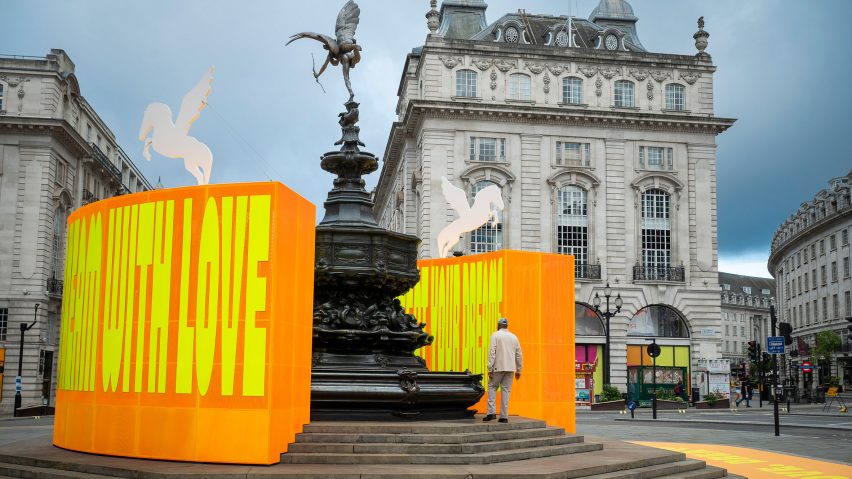British-Nigerian designer Yinka Ilori has partially enclosed the Eros fountain at Piccadilly Circus in central London with a pair of brightly coloured plinths.
Named Good Things Come to Those Who Wait, the installation was designed to create a positive message at the centre of one of the city's busiest junctions.
The artwork consists of a pair of Pegasus's each perched on top of a bright orange, curved plinth made from perforated metal. Each plinth is nestled into the steps surrounding the 19th-century Shaftesbury Memorial Fountain, popularly known as Eros, on the southeastern side of Piccadilly Circus.
"Storytelling is the heartbeat my work," Ilori told Dezeen. "Whether it's a public art installation or an object, every project of mine is inspired by a story.
"The beautiful thing about stories is they have the power to bring people together, to spark connectivity, evoke memories, and inspire optimism," he continued.
"This is what I hoped to do through this installation, I wanted to make it as big, loud, and bright as possible, so it would bring people together to connect, engage and experience feelings of joy and positivity."
The orange plinths are adorned with the words "dream with love" and "protect your dreams" in bright yellow. The text is written in Yinka Sans Ultra – a custom typeface created for Ilori by type foundry British Standard Type.
Sat on top of the seven-metre-high plinths, the winged horses from Greek mythology are a nod to the statue that tops the fountain. Although the statue is commonly known as Eros, it actually depicts Eros's brother Anteros.
In Greek mythology, the winged horse Pegasus was born from the blood of Medusa after she was beheaded by the hero Perseus.
"I've always been obsessed with folklore," explained Ilori." I like the cultural link between Greek mythology and Nigerian mythology, and this installation sees these two coming together."
"The installation is based on the Greek tale of Pegasus, which is why you'll see the two winged horses at the top of the structure, and the Greek God of Love, Anteros in the centre," he continued.
"The installation is then wrapped with affirmations, which are central to my work. I hope people follow the affirmations and walk around the structure in a somewhat poetic experience."
Ilori hopes that the public will engage and interact with the installation, which was created with Art of London and will be in place until the end of the month.
"I've always believed art and design should be free and accessible to all, which is why you'll often see my work in public spaces," he said.
"People aren't often able to touch art in public galleries and museums, which I feel causes a disconnect of what it should feel like. So, to me, the joy from this project really comes from watching children and families interact with the installation."
It is the latest installation created by Ilori in his signature bright colours. He recently designed a mirrored pavilion for self-reflection in Germany and a pair oversized chairs in east London.

